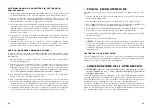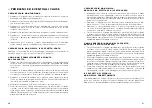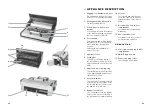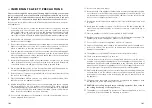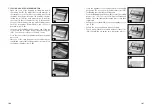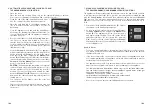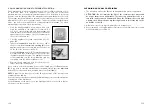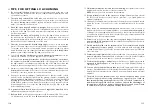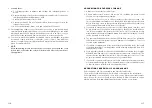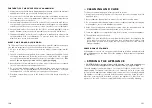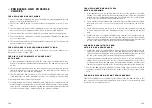
115
12.
Fluids must always be cooled before vacuuming.
Hot liquids foam or form
bubbles and increase in volume if they are vacuumed.
NOTE:
Use only our Solis-containers for vacuuming.
13.
Keep perishable foods in the freezer or fridge.
Vacuum packing extends
the life of food, but does not turn it into a „preserve“, i.e. a stable product at
ambient temperature.
14. Fill a bag 2/3 full with water, seal the end of the bag (do no vacuum!) and lay the
bag in the freezer. You can use the ice for cooling drinks but also for sporting
injuries.
15. Many
foods
are
already vacuum packed
when bought, such as cheese or
ready meals. With our vacuuming-appliance, you
can vacuum them again
(in
Solis bags!), if the packaging has been opened, so that it stays fresh and retains
it's full flavour. However, these foods should still only be consumed up until the
date printed on the original packaging.
16.
Cereals
such as flour, rice and cake mixes
stay fresh longer if they are vac-
uum packed. Nuts and spices
hold their flavour better and will not go rancid.
Ideal for long journeys.
17.
Freshly washed salads can be vacuumed in a Solis container and kept in
the refrigerator for up to a week
– so there is always fresh and crispy salad
to hand at meal times. If you line the container with a paper towel it will absorb
excess moisture.
18.
Powdered or small grain foods
can be vacuumed in Solis containers, if kitchen
paper is placed on top of the food
as a barrier so that the powder or grains
can not get into the suction pump or inside the air extraction hose.
19.
Foods with sharp edges and points,
such as bones or dry pasta should be
wrapped in kitchen paper
so that they can no longer damage the bag or
cause punctures.
20.
You can also vacuum pack more than just food.
Camping products such as
matches, first aid bandages or clothing stay clean and dry when vacuum packed.
Vacuum packed silverware doesn't tarnish, a vacuum packed candle is always
advisable.
21.
The main use of the vacuum sealer is to conveniently keep many foods
fresh for longer without losing their flavour. In general you could say
that vacuum packing quadruples the shelf life of foods in comparison to
traditional storage methods. Once you have enjoyed the advantages of
this appliance, it will soon become indispensible to you and you will have
to throw much less food away and thereby save money.
114
s
TIPS FOR OPTIMAL VACUUMING
1.
Do not overfill the bag.
Always leave enough empty space at the end of the
bag so that it can be placed in the vacuum chamber without problem and with-
out wrinkles or creases.
2.
The open bag end should not be wet,
since wet bags can not be sealed.
If the foods contain moisture or the bag is wet on the inside, you should choose
the highest
Sealing time
setting to prolong sealing time and to seal with two
welds. This improves the final result.
3.
Clean the open bag end and pull it straight,
before you seal it. Make sure
that there is no food residue on the end of the bag and that there are no creases
in the end of the bag. The sealed seam must be completely smooth, otherwise
it will not be airtight.
4.
Never leave too much air in the bag.
Press on the bag a little to get most of
the air out before vacuuming. Too much air in the bag means more work for
the vacuum pump, which could overload the motor. The consequence could be
that not all of the air is vacuumed out of the bag.
5.
Please do not vacuum foods with sharp edges,
such as e.g. fish bones and
mussels. The sharp edges can cut through the film so that it is no longer airtight.
To vacuum such foods we recommend using a container instead of a plastic
bag. Alternatively you can
cover
the sharp edges and ends with
folded kitchen
paper
so that it cannot damage the bag or poke holes in it.
6. You should
wait for a minute after every vacuum programme
before you
vacuum the next bag, so that the appliance can cool down.
7. If the necessary
vacuum pressure has not been reached after one minute,
the appliance will
switch off automatically.
If this happens, please check if
the bag/container is not airtight or whether the end of the bag is not clean and
straight in the vacuum chamber or whether there is another possible reason.
8. Always check whether the
ring seals
on the vacuum chamber are
dirty
or have
deformations or cracks
. If the former is the case, clean and dry the ring seals,
if the latter is the case, replace the seals with new ones.
9. During the vacuum programme, small quantities of liquids, crumbs or food
particles can be accidentally sucked into the vacuum chamber, cloggin up the
vacuum pump and damaging your appliance. To avoid this, we recommend
first
freezing juicy or moist foods,
before you vacuum them in the bag, or place
folded kitchen paper to form a barrier. For powdery or finely ground foods the
following applies: do not overfill the bag and place a coffee filter in the bag
before vacuuming the bag.
10. In
gereneral fruits should be pre-frozen
and
vegetables blanched
before
vacuuming in order to achieve best results.
11.
Delicate foods
such as pastries or berries should be vacuumed in Solis contain-
ers. Alternatively, freeze the food
24 hours before
vacuuming in a bag.


